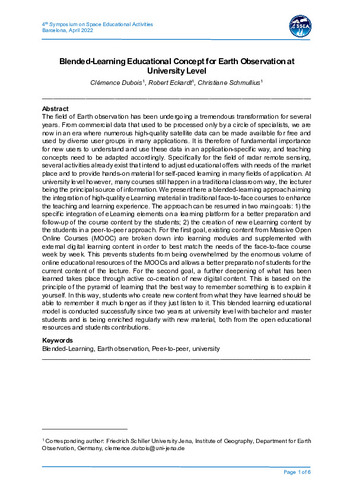Blended-learning educational concept for earth observation at university level

Visualitza/Obre
10.5821/conference-9788419184405.046
Inclou dades d'ús des de 2022
Cita com:
hdl:2117/369411
Tipus de documentComunicació de congrés
Data publicació2022-04-29
EditorUniversitat Politècnica de Catalunya
Condicions d'accésAccés obert
Llevat que s'hi indiqui el contrari, els
continguts d'aquesta obra estan subjectes a la llicència de Creative Commons
:
Reconeixement-NoComercial-SenseObraDerivada 4.0 Internacional
Abstract
The field of Earth observation has been undergoing a tremendous transformation for several years. From commercial data that used to be processed only by a circle of specialists, we are now in an era where numerous high-quality satellite data can be made available for free and used by diverse user groups in many applications. It is therefore of fundamental importance for new users to understand and use these data in an application-specific way, and teaching concepts need to be adapted accordingly. Specifically for the field of radar remote sensing, several activities already exist that intend to adjust educational offers with needs of the market place and to provide hands-on material for self-paced learning in many fields of application. At university level however, many courses still happen in a traditional classroom way, the lecturer being the principal source of information. We present here a blended-learning approach aiming the integration of high-quality eLearning material in traditional face-to-face courses to enhance the teaching and learning experience. The approach can be resumed in two main goals: 1) the specific integration of eLearning elements on a learning platform for a better preparation and follow-up of the course content by the students; 2) the creation of new eLearning content by the students in a peer-to-peer approach. For the first goal, existing content from Massive Open Online Courses (MOOC) are broken down into learning modules and supplemented with external digital learning content in order to best match the needs of the face-to-face course week by week. This prevents students from being overwhelmed by the enormous volume of online educational resources of the MOOCs and allows a better preparation of students for the current content of the lecture. For the second goal, a further deepening of what has been learned takes place through active co-creation of new digital content. This is based on the principle of the pyramid of learning that the best way to remember something is to explain it yourself. In this way, students who create new content from what they have learned should be able to remember it much longer as if they just listen to it. This blended learning educational model is conducted successfully since two years at university level with bachelor and master students and is being enriched regularly with new material, both from the open educational resources and students contributions
CitacióDubois, C.; Eckardt, R.; Schmullius, C. Blended-learning educational concept for earth observation at university level. A: "4th Symposium on Space Educational Activities". Universitat Politècnica de Catalunya, 2022,
ISBN9788419184405
| Fitxers | Descripció | Mida | Format | Visualitza |
|---|---|---|---|---|
| SSEA_2022_115.pdf | 708,2Kb | Visualitza/Obre |


